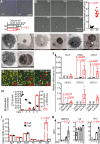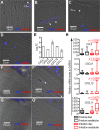Novel Insights into Staphylococcus aureus Deep Bone Infections: the Involvement of Osteocytes
- PMID: 29691335
- PMCID: PMC5915738
- DOI: 10.1128/mBio.00415-18
Novel Insights into Staphylococcus aureus Deep Bone Infections: the Involvement of Osteocytes
Abstract
Periprosthetic joint infection (PJI) is a potentially devastating complication of orthopedic joint replacement surgery. PJI with associated osteomyelitis is particularly problematic and difficult to cure. Whether viable osteocytes, the predominant cell type in mineralized bone tissue, have a role in these infections is not clear, although their involvement might contribute to the difficulty in detecting and clearing PJI. Here, using Staphylococcus aureus, the most common pathogen in PJI, we demonstrate intracellular infection of human-osteocyte-like cells in vitro and S. aureus adaptation by forming quasi-dormant small-colony variants (SCVs). Consistent patterns of host gene expression were observed between in vitro-infected osteocyte-like cultures, an ex vivo human bone infection model, and bone samples obtained from PJI patients. Finally, we confirm S. aureus infection of osteocytes in clinical cases of PJI. Our findings are consistent with osteocyte infection being a feature of human PJI and suggest that this cell type may provide a reservoir for silent or persistent infection. We suggest that elucidating the molecular/cellular mechanism(s) of osteocyte-bacterium interactions will contribute to better understanding of PJI and osteomyelitis, improved pathogen detection, and treatment.IMPORTANCE Periprosthetic joint infections (PJIs) are increasing and are recognized as one of the most common modes of failure of joint replacements. Osteomyelitis arising from PJI is challenging to treat and difficult to cure and increases patient mortality 5-fold. Staphylococcus aureus is the most common pathogen causing PJI. PJI can have subtle symptoms and lie dormant or go undiagnosed for many years, suggesting persistent bacterial infection. Osteocytes, the major bone cell type, reside in bony caves and tunnels, the lacuno-canalicular system. We report here that S. aureus can infect and reside in human osteocytes without causing cell death both experimentally and in bone samples from patients with PJI. We demonstrate that osteocytes respond to infection by the differential regulation of a large number of genes. S. aureus adapts during intracellular infection of osteocytes by adopting the quasi-dormant small-colony variant (SCV) lifestyle, which might contribute to persistent or silent infection. Our findings shed new light on the etiology of PJI and osteomyelitis in general.
Keywords: Staphylococcus aureus; bone infection; osteomyelitis; periprosthetic joint infection; small-colony variant; stress adaptation.
Copyright © 2018 Yang et al.
Figures


References
-
- Wimmer MD, Friedrich MJ, Randau TM, Ploeger MM, Schmolders J, Strauss AA, Hischebeth GT, Pennekamp PH, Vavken P, Gravius S. 2016. Polymicrobial infections reduce the cure rate in prosthetic joint infections: outcome analysis with two-stage exchange and follow-up ≥two years. Int Orthop 40:1367–1373. doi:10.1007/s00264-015-2871-y. - DOI - PubMed
Publication types
MeSH terms
LinkOut - more resources
Full Text Sources
Other Literature Sources
Medical
